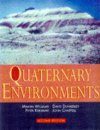Cancelled
By: Martin Williams, David Dunkerley, Patrick De Deckker and Peter Kershaw
329 pages, B/w photos, illus, figs, tabs, maps
![Quaternary Environments Quaternary Environments]()
Click to have a closer look
About this book
Contents
Related titles
About this book
Examines the global environmental fluctuations of the Quaternary period, and considers the response of living organisms to past environmental change, focussing on the interaction between geological, biological and hydrological processes that have given rise to the present-day distribution of geomorphic, biogeographic and climatic regions throughout the world.
Contents
Quaternary environments - an introduction; prelude to the quaternary; quaternary glaciations - causes and feedback mechanisms; the Milankovitch hypothesis and quaternary environments; quaternary sea level changes; evidence from the deserts; evidence from terrestrial flora and fauna; human origins, innovation and migrations; atmospheric circulation during the quaternary; environmental changes - past, present, future.
Customer Reviews
Cancelled
By: Martin Williams, David Dunkerley, Patrick De Deckker and Peter Kershaw
329 pages, B/w photos, illus, figs, tabs, maps
The strengths of Quaternary Environments lies in its authoritative style, breadth of coverage both systematic and regional...and emphasis on linkages between the different components of the natural environment. -- The Times Higher Educational Supplement ...a world-beating authoritative and scholarly text...useful, stimulating textbook which presents evidence for Quaternary environmental changes with an impressive global perspective. -- The Holocene A world-beating authoritative and scholarly text which eclipses many simiular book on the market...most comprehensive account...illustrated, extensively referenced...should be consdiered a must for bookshelves of researchers and graduates -- The Holocene Clearly written and well structured. Figures and tables are impressive. Altogether this is an exciting book that can be highly reccomended to anyone interested in learning more about quartenary environments. -- Journal of Atmospheric chemistry Very likely to become the standard source of information for anyone interested in quaternary research. A valuable source of information even for advanced researchers.The contents have been chosen with great care and thoughtfulness. Not only the contents but also the presentation and the didactic quality of the book leaves no room for criticism. The layout of the book is state-of-the-art, graphs and pictures are clear and of superb quality and the price is acceptable. -- Journal of Quaternary Science The second edition of a very fine textbook that should prove valuable to students of this increasingly important field of study. The authors are to be congratulated. A team of distinguished Australian university academics each one of whom has a deservedly excellent reputation in the various subdisciplines associated with the increasingly popular field of Quaternary science. Aimed primarily at the undergraduate market. Nevertheless, there is enough detail and development here to provide very useful and up-to-date resources for postgraduate students and researchers. -- Progress in Physical Geography































